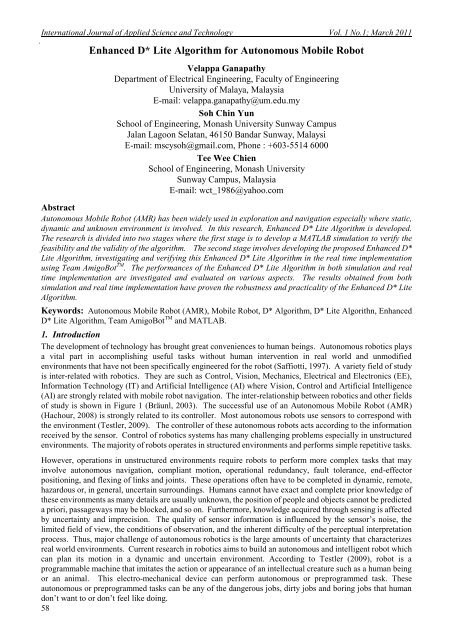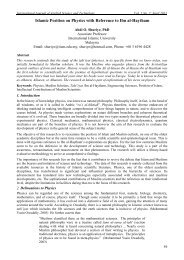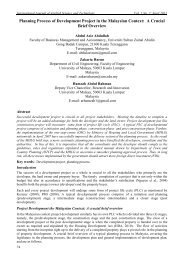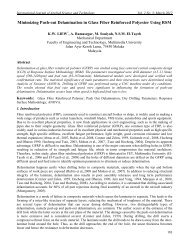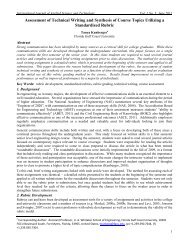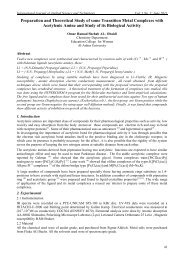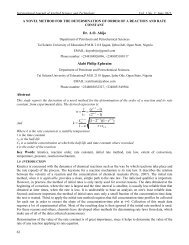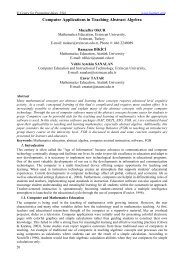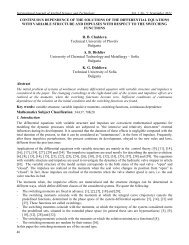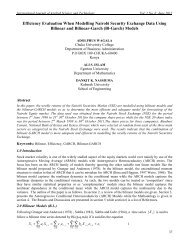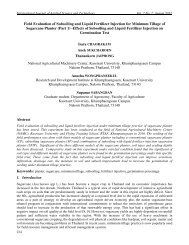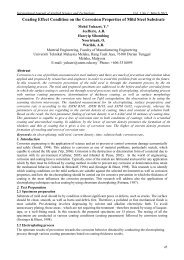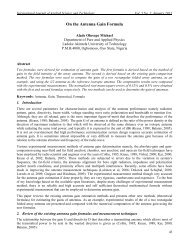Enhanced D* Lite Algorithm for Autonomous Mobile Robot
Enhanced D* Lite Algorithm for Autonomous Mobile Robot
Enhanced D* Lite Algorithm for Autonomous Mobile Robot
Create successful ePaper yourself
Turn your PDF publications into a flip-book with our unique Google optimized e-Paper software.
International Journal of Applied Science and Technology Vol. 1 No.1; March 2011<br />
<strong>Enhanced</strong> <strong>D*</strong> <strong>Lite</strong> <strong>Algorithm</strong> <strong>for</strong> <strong>Autonomous</strong> <strong>Mobile</strong> <strong>Robot</strong><br />
Velappa Ganapathy<br />
Department of Electrical Engineering, Faculty of Engineering<br />
University of Malaya, Malaysia<br />
E-mail: velappa.ganapathy@um.edu.my<br />
Soh Chin Yun<br />
School of Engineering, Monash University Sunway Campus<br />
Jalan Lagoon Selatan, 46150 Bandar Sunway, Malaysi<br />
E-mail: mscysoh@gmail.com, Phone : +603-5514 6000<br />
Tee Wee Chien<br />
School of Engineering, Monash University<br />
Sunway Campus, Malaysia<br />
E-mail: wct_1986@yahoo.com<br />
Abstract<br />
<strong>Autonomous</strong> <strong>Mobile</strong> <strong>Robot</strong> (AMR) has been widely used in exploration and navigation especially where static,<br />
dynamic and unknown environment is involved. In this research, <strong>Enhanced</strong> <strong>D*</strong> <strong>Lite</strong> <strong>Algorithm</strong> is developed.<br />
The research is divided into two stages where the first stage is to develop a MATLAB simulation to verify the<br />
feasibility and the validity of the algorithm. The second stage involves developing the proposed <strong>Enhanced</strong> <strong>D*</strong><br />
<strong>Lite</strong> <strong>Algorithm</strong>, investigating and verifying this <strong>Enhanced</strong> <strong>D*</strong> <strong>Lite</strong> <strong>Algorithm</strong> in the real time implementation<br />
using Team AmigoBot TM . The per<strong>for</strong>mances of the <strong>Enhanced</strong> <strong>D*</strong> <strong>Lite</strong> <strong>Algorithm</strong> in both simulation and real<br />
time implementation are investigated and evaluated on various aspects. The results obtained from both<br />
simulation and real time implementation have proven the robustness and practicality of the <strong>Enhanced</strong> <strong>D*</strong> <strong>Lite</strong><br />
<strong>Algorithm</strong>.<br />
Keywords: <strong>Autonomous</strong> <strong>Mobile</strong> <strong>Robot</strong> (AMR), <strong>Mobile</strong> <strong>Robot</strong>, <strong>D*</strong> <strong>Algorithm</strong>, <strong>D*</strong> <strong>Lite</strong> Algorithn, <strong>Enhanced</strong><br />
<strong>D*</strong> <strong>Lite</strong> <strong>Algorithm</strong>, Team AmigoBot TM and MATLAB.<br />
1. Introduction<br />
The development of technology has brought great conveniences to human beings. <strong>Autonomous</strong> robotics plays<br />
a vital part in accomplishing useful tasks without human intervention in real world and unmodified<br />
environments that have not been specifically engineered <strong>for</strong> the robot (Saffiotti, 1997). A variety field of study<br />
is inter-related with robotics. They are such as Control, Vision, Mechanics, Electrical and Electronics (EE),<br />
In<strong>for</strong>mation Technology (IT) and Artificial Intelligence (AI) where Vision, Control and Artificial Intelligence<br />
(AI) are strongly related with mobile robot navigation. The inter-relationship between robotics and other fields<br />
of study is shown in Figure 1 (Bräunl, 2003). The successful use of an <strong>Autonomous</strong> <strong>Mobile</strong> <strong>Robot</strong> (AMR)<br />
(Hachour, 2008) is strongly related to its controller. Most autonomous robots use sensors to correspond with<br />
the environment (Testler, 2009). The controller of these autonomous robots acts according to the in<strong>for</strong>mation<br />
received by the sensor. Control of robotics systems has many challenging problems especially in unstructured<br />
environments. The majority of robots operates in structured environments and per<strong>for</strong>ms simple repetitive tasks.<br />
However, operations in unstructured environments require robots to per<strong>for</strong>m more complex tasks that may<br />
involve autonomous navigation, compliant motion, operational redundancy, fault tolerance, end-effector<br />
positioning, and flexing of links and joints. These operations often have to be completed in dynamic, remote,<br />
hazardous or, in general, uncertain surroundings. Humans cannot have exact and complete prior knowledge of<br />
these environments as many details are usually unknown, the position of people and objects cannot be predicted<br />
a priori, passageways may be blocked, and so on. Furthermore, knowledge acquired through sensing is affected<br />
by uncertainty and imprecision. The quality of sensor in<strong>for</strong>mation is influenced by the sensor‟s noise, the<br />
limited field of view, the conditions of observation, and the inherent difficulty of the perceptual interpretation<br />
process. Thus, major challenge of autonomous robotics is the large amounts of uncertainty that characterizes<br />
real world environments. Current research in robotics aims to build an autonomous and intelligent robot which<br />
can plan its motion in a dynamic and uncertain environment. According to Testler (2009), robot is a<br />
programmable machine that imitates the action or appearance of an intellectual creature such as a human being<br />
or an animal. This electro-mechanical device can per<strong>for</strong>m autonomous or preprogrammed task. These<br />
autonomous or preprogrammed tasks can be any of the dangerous jobs, dirty jobs and boring jobs that human<br />
don‟t want to or don‟t feel like doing.<br />
58
© Centre <strong>for</strong> Promoting Ideas, USA www.ijastnet.com<br />
A number of software has been developed to control actions and movements of mobile robots to accomplish<br />
those preprogrammed or autonomous tasks. All these software needs effective motion planning. Motion<br />
planning is often designed to optimize specific per<strong>for</strong>mance criteria and to satisfy constraints on the robot‟s<br />
motion (Kam et al., 1997). Typical per<strong>for</strong>mance criteria are minimum time to arrive at a milestone and<br />
minimum control ef<strong>for</strong>t. Typical constraints in the motion planning are obstacle avoidance and maximum robot<br />
velocity. But apparently, due to the lack of in-depth consideration from all aspects or the misunderstanding<br />
which occurs during the requirements capturing processes, some problems were found in these developed<br />
systems. More and more problems have arisen in the development of the robots boasting. Among them, the<br />
problem of getting the accurate and shortest path in the robot navigation is quite apparent in the development of<br />
robotics. The robot navigation can be accomplished through behavior arbitration (Saffiotti, 1997) and<br />
hierarchical behavior control (Tunstel et al., 1997). Some of these basic behaviors are Goal Seeking, Obstacle<br />
Avoidance and Wall Following.<br />
<strong>Mobile</strong> robot is one of the developed advanced technologies which assist humans in various purposes and tasks<br />
in many application fields such as education, service, industry, exploration, transportation, and more. In<br />
exploration and observation field, robot is used to explore the environment that is new or not reachable by<br />
humans. ROBOVOLC (Sim et al., 2003) is one of the examples of robots which designed <strong>for</strong> exploration and<br />
measurement in volcanic environment as it might be dangerous <strong>for</strong> volcanologist to do. In industry application,<br />
mobile robot is mainly used <strong>for</strong> transporting the materials from one point to another. It is known as Automated<br />
Guided Vehicle (AGV) (Garcia et al., 2007). By using AGV in the industry, the cost can be minimized and<br />
efficiency can be increased. <strong>Mobile</strong> robot relies on sensors to get in<strong>for</strong>mation about their surroundings (Testler,<br />
2009). Normally, mobile robot is equipped with various types of sensors in order to guide the robot to achieve<br />
its purpose. Some sensor appliances, image capturing devices or a combination of both sensing and image<br />
capturing devices can be treated as supporting appliances in robots navigation. These appliances capture image<br />
data from these devices and use vision algorithms <strong>for</strong> analysis of the terrain (Howard et al., 2001) or sensor<br />
fusion to translate different sensory inputs into reliable estimates and environmental models (Kam et al., 1997).<br />
These image data are utilized in order to get a better reading of obstacles‟ features such as the distance between<br />
the robot and obstacle, the size of the obstacle and so on. Thus, location and type of sensors are essential<br />
aspects in the mobile robot navigation. Choosing the right sensors <strong>for</strong> the robot and locating them on the robot<br />
effectively are important in getting the best per<strong>for</strong>mance of the robot. The number of sensors installed on the<br />
robot also needs to be considered and this is to be as few as possible. Navigation is one of the important<br />
purposes that uses mobile robot (Franz & Mallot, 2000). <strong>Mobile</strong> robot navigation is the technique to guide the<br />
mobile robot moving from the starting position towards the desired goal, along a desired path or accomplishing<br />
the desired purposes where static, dynamic, known and unknown environment is involved (Velappa et al.,<br />
2009a). The environment of mobile robot navigation is distinguished by variable terrain, a set of distinct<br />
objects or certain objects such as obstacles, milestones, and landmarks (Kam et al., 1997) that may block the<br />
movement of the robot in reaching the desired destination or accomplishing the desired purposes. The<br />
environment <strong>for</strong> navigation could be known or unknown with moving and static obstacles.<br />
The environment with static obstacles is called static environment meanwhile the environment with moving<br />
obstacles that causes the locations of the obstacles change with time is called dynamic environment. Unknown<br />
environment is the environment where the locations of the obstacles are unknown to the mobile robot while<br />
known environment is the environment where the locations of the obstacles are known to the mobile robot<br />
be<strong>for</strong>e navigation is carried out. One common requirement <strong>for</strong> the mobile robot, independent of the operating<br />
domain, is the capability of intelligent navigation. <strong>Autonomous</strong> <strong>Mobile</strong> <strong>Robot</strong> (AMR) has to find the near<br />
optimal collision free path from the starting point to the desired goal. Some of the mobile robot navigation<br />
purposes are such as navigation <strong>for</strong> exploring unknown planet (Fu et al., 2006; Eustice et al., 2008), navigation<br />
<strong>for</strong> military purpose (Alvarez et al., 2004; Kim & Eustice, 2009 ), goal directed navigation (Velappa et al.,<br />
2009a; Velappa et al., 2009b; Velappa et al., 2009c) and path finding (Wang & Liu, 2004).<br />
For goal-directed navigation, a mobile robot has to move from the given starting position towards the goal<br />
position with the capability to avoid obstacles. The mobile robot should also be able to traverse in both known<br />
and unknown environments. Besides, time to traverse from starting point to goal point is also an important<br />
aspect emphasized by researches. It is important <strong>for</strong> mobile robot to plan a shortest path from starting point to<br />
goal point. Moreover, the mobile robot must be able to re-plan its path quickly if there is a new obstacle in front<br />
or nearby. Some of the existing goal-direct navigation algorithms are such as A* <strong>Algorithm</strong> (Lester, 2009), <strong>D*</strong><br />
<strong>Algorithm</strong> (Stentz, 1994; Ferguson & Stentz, 2006; Choset et al., 2007), and <strong>D*</strong> <strong>Lite</strong> <strong>Algorithm</strong> (Koenig &<br />
Likhachev, 2002; Likhachev & Koenig, 2002; Koenig & Likhachev, 2005).<br />
59
International Journal of Applied Science and Technology Vol. 1 No.1; March 2011<br />
A* <strong>Algorithm</strong> (Lester, 2009) is an early developed popular graph search algorithm which finds the shortest path<br />
from a given initial start node to the goal node. A* <strong>Algorithm</strong> uses distance plus path cost function to determine<br />
the shortest path to the goal node. In A* <strong>Algorithm</strong>, node or square notation is used rather than coordinate<br />
because a map is divided into small grids or squares and nodes represent the center point of each grid <strong>D*</strong><br />
<strong>Algorithm</strong>, which is also known as Stentz algorithm or Dynamic A* <strong>Algorithm</strong>, is developed by Anthony Stentz<br />
in 1994. It is better than A* <strong>Algorithm</strong> because it could be used in partially or completely unknown and also<br />
dynamic environment. Dynamic environment means there might contain moving obstacles. A* <strong>Algorithm</strong> is a<br />
simple algorithm which could be only used in static environment. But <strong>D*</strong> <strong>Algorithm</strong> is able to repair or update<br />
the map of the dynamic environment and it can re-plan quickly whenever it detects there is a new obstacle or an<br />
obstacle is removed on the way to goal node (Stentz, 1994).<br />
<strong>D*</strong> <strong>Lite</strong> <strong>Algorithm</strong> (Koenig & Likhachev, 2002; Likhachev & Koenig, 2002; Koenig & Likhachev, 2005) is one<br />
of most popular goal-directed navigation algorithm that is widely used <strong>for</strong> mobile robot navigation in unknown<br />
environment. <strong>D*</strong> <strong>Lite</strong> <strong>Algorithm</strong> is a reverse or backward searching method and it is able to re-plan from<br />
current position when there is a new obstacle blocking the path. It determines the same paths as <strong>D*</strong> <strong>Algorithm</strong><br />
and moves the mobile robot the same way but it is algorithmically different from <strong>D*</strong> <strong>Algorithm</strong>. <strong>D*</strong> <strong>Lite</strong><br />
<strong>Algorithm</strong> is developed by Koenig and Likhachev (Koenig & Likhachev, 2002; Likhachev & Koenig, 2002;<br />
Koenig & Likhachev, 2005) based on Lifelong Planning A* (Koenig et al., 2004) <strong>Algorithm</strong> in 2002. It has<br />
been widely used <strong>for</strong> mobile robot navigation in unknown environment. Similarly, it divides the environment<br />
into grids and path finding and robot‟s movement are from grid to grid.<br />
From the study and review of existing <strong>D*</strong> <strong>Lite</strong> <strong>Algorithm</strong>, the main problems of the algorithm are mobile robot<br />
is traversing across obstacles‟ sharp corners, traversing in between two obstacles, and trapped in the<br />
„U-Shaped‟ type obstacles. Also there is no real time implementation reported. To overcome the mentioned<br />
problems, <strong>Enhanced</strong> <strong>D*</strong> <strong>Lite</strong> <strong>Algorithm</strong> has been implemented. In this research, the existing <strong>D*</strong> <strong>Lite</strong> <strong>Algorithm</strong><br />
is investigated in detail and enhancements are emphasized on (i) preventing mobile robot from traversing across<br />
obstacles‟ sharp corners, (ii) avoiding complicated obstacles such as U-shaped obstacles, or obstacles that trap<br />
the mobile robot from moving, (iii) preventing mobile robot from traversing in between two obstacles, (iv)<br />
creating virtual wall if necessary, and (v) removing unnecessary pathways to yield shortest path. The<br />
per<strong>for</strong>mances of the <strong>Enhanced</strong> <strong>D*</strong> <strong>Lite</strong> <strong>Algorithm</strong> in both simulation and real time implementation are<br />
investigated and evaluated on various aspects including (i) the ability to avoid obstacles (ii) finding a shortest<br />
path from goal to start position in dynamic environment (back propagation method), (iii) remembering the path,<br />
and (iv) following back the same path and returning to the goal position.<br />
2. System Overview<br />
Consider a mobile robot navigation task in an environment with „U-shaped‟ type obstacles as shown in Figure 2,<br />
where no in<strong>for</strong>mation about the obstacles positions is provided to the mobile robot. It has to find a shortest path<br />
from the goal position towards starting position (back propagation). It will compute a shortest path from its<br />
current position with respect to the starting position until it reaches starting position. In this research, the<br />
mobile robot environment is represented by grids (Michalewicz, 1994). White grids are known to be<br />
traversable, black grids are known to be obstacles, which are untraversable and round dot representing mobile<br />
robot. Referring to Figure 2, the mobile robot will traverse vertically up towards the starting position since that<br />
is the shortest path to reach starting position from goal position and it assumes all grids are traversable. As the<br />
mobile robot is traversing vertically towards starting position, it is trapped in the „U-shaped‟ type obstacles as<br />
shown in Figure 2B. Eventually the sensors of the mobile robot will detect and realize that there is an obstacle<br />
blocking in front of the mobile robot.<br />
The mobile robot will continue to search <strong>for</strong> other grids and check if there is a new path to reach starting<br />
position. The only traversable grid now is the grid behind the mobile robot which means the mobile robot has to<br />
traverse out from the „U-shaped‟ type obstacles. As the mobile robot traverses out from the „U-shaped‟ type<br />
obstacles, virtual walls will be created to make sure the same grids would not be traversed again. This is shown<br />
in Figure 2C and Figure 2D. The mobile robot is able to escape out from the „U-shaped‟ type obstacles and<br />
continue to find the shortest path in order to reach starting position. Referring to Figure 2D, as the mobile robot<br />
traverses across obstacle‟s sharp corner, a minimum clearance distance is provided between obstacle‟s sharp<br />
corner and mobile robot. This is important to prevent any damages of mobile robot. Finally, the mobile robot is<br />
able to reach starting position as shown in Figure 2E. Once the mobile robot has reached the starting position,<br />
it will follow back the path found just now and return to goal position as illustrated in Figure 2F and Figure 2G.<br />
No more path finding is required. For the shortest path found travelling from goal to starting position, if there<br />
are unnecessary pathways, it would be removed as shown in Figure 2H. This is the navigation strategy of<br />
<strong>Enhanced</strong> <strong>D*</strong> <strong>Lite</strong> <strong>Algorithm</strong>.<br />
60
© Centre <strong>for</strong> Promoting Ideas, USA www.ijastnet.com<br />
3. <strong>Enhanced</strong> <strong>D*</strong> <strong>Lite</strong> <strong>Algorithm</strong><br />
Basically, the path finding principle of <strong>Enhanced</strong> <strong>D*</strong> <strong>Lite</strong> <strong>Algorithm</strong> is the same as existing <strong>D*</strong> <strong>Lite</strong> <strong>Algorithm</strong>.<br />
However, <strong>Enhanced</strong> <strong>D*</strong> <strong>Lite</strong> <strong>Algorithm</strong> has been implemented with five additional features which are<br />
mentioned in Section 1. Coordinate specification used to represent positions in <strong>Enhanced</strong> <strong>D*</strong> <strong>Lite</strong> <strong>Algorithm</strong> is<br />
(i, j) where i is the row and j is the column. <strong>Enhanced</strong> <strong>D*</strong> <strong>Lite</strong> <strong>Algorithm</strong> is using back propagation searching<br />
method as in <strong>D*</strong> <strong>Lite</strong> <strong>Algorithm</strong> to find the shortest path. Back propagation searching method is where the path<br />
finding search will start from goal position towards starting position. Details of how the <strong>Enhanced</strong> <strong>D*</strong> <strong>Lite</strong><br />
<strong>Algorithm</strong> works would be explained in the following steps.<br />
(i) Calculate h (Heuristic) value<br />
The first step of the <strong>Enhanced</strong> <strong>D*</strong> <strong>Lite</strong> <strong>Algorithm</strong> is to calculate the h (heuristic) value. Starting position<br />
is assigned with an h value of 0. The h value is incremented by 1 from grid to grid until all grids are<br />
assigned with the respective h values as seen in Figure 3. Increment of h value is done vertically,<br />
horizontally, and diagonally with the condition that the smallest h value is taken from the starting position<br />
to the goal position.<br />
(ii) Calculate rhs (Look Ahead Function) and g (Cost Function) values<br />
Initially, each grid of the environment is assigned with g and rhs values to infinity. rhs(i, j) is a look<br />
ahead function. rhs values will be re-calculated when the grids are analyzed. Formula of the rhs is shown<br />
below.<br />
rhs ( i,<br />
j)<br />
min[ succ(<br />
i,<br />
j)(<br />
g)]<br />
1<br />
(1)<br />
where g g values of rhs(<br />
i,<br />
j)<br />
successors<br />
g(i, j) is cost function and g value will be re-calculated when the grid is expanded. The <strong>for</strong>mula of g is<br />
shown below.<br />
g( i,<br />
j)<br />
rhs(<br />
i,<br />
j)<br />
(2)<br />
(iii) Calculate k1 and k2 (Priority Queue Function) values<br />
Basically, k1 and k2 are priority queue functions. k1 and k2 values would be calculated when the grid(s)<br />
is/are analyzed by mobile robot. Grid with the smallest k1 value will be expanded. Formula <strong>for</strong><br />
calculating k1 and k2 are shown below.<br />
k1(<br />
i,<br />
j)<br />
rhs(<br />
i,<br />
j)<br />
h(<br />
i,<br />
j)<br />
(3)<br />
k2(<br />
i,<br />
j)<br />
min[ g(<br />
i,<br />
j),<br />
rhs(<br />
i,<br />
j)]<br />
(4)<br />
Path finding will stop when k1 value is equal to k2 value. This indicates that the mobile robot has reached<br />
the starting position.<br />
(iv) Initialization<br />
After defining all the variables and their respective functions in <strong>Enhanced</strong> <strong>D*</strong> <strong>Lite</strong> <strong>Algorithm</strong>,<br />
initialization is to be per<strong>for</strong>med be<strong>for</strong>e path finding starts. First, rhs value of goal position is set to value<br />
of 0, k1 and k2 values of goal position are calculated and g value of goal position is set equal to rhs value<br />
of goal position.<br />
(v) Compute Shortest Path<br />
Next, the surrounding grids will be analyzed using sonar sensors. This is to confirm if the grid is free of<br />
obstacles and could be traversed. In this research, the mobile robot, Team AmigoBot TM (<strong>Mobile</strong><strong>Robot</strong>s,<br />
2007), is used. Team AmigoBot TM comes with eight built-in sonar sensors. The structure of the Team<br />
AmigoBot TM is shown in Figure 4.<br />
Referring to Figure 4, s1 to s6 are the front sensors and s7 and s8 are the rear sensors. The angles of all the<br />
mounted sensors are shown in Figure 5. Positive angle is to the left and negative angle is to the right. Array S<br />
is used to store the sonar sensors‟ readings obtained from the environment. S is represented mathematically as<br />
below:<br />
S [ s1<br />
s2<br />
s3<br />
s4<br />
s5<br />
s6<br />
s7<br />
s8]<br />
(5)<br />
where s1- s8 are eight sensor readings indicating the configurations of the nearest obstacles to the mobile robot<br />
from the current position. Figure 6 shows the position of the mobile robot <strong>for</strong> grid analysis. Basically, there are<br />
eight grids surrounding the mobile robot labeled grid A to grid H. Selection procedures of the grid(s) to be<br />
updated with new rhs, k1 and k2 values are shown in the flowchart in Figure 7. The grid(s) updated with the<br />
new values would be the potential next grid to be expanded. Referring to the flowchart in Figure 7, <strong>for</strong> each of<br />
the eight grids surrounding the mobile robot, this <strong>Enhanced</strong> <strong>D*</strong> <strong>Lite</strong> <strong>Algorithm</strong> will start with the verification if<br />
the particular grid is free of obstacle by analyzing the sonar sensors readings. If the grid is not free of obstacle,<br />
it will be checked <strong>for</strong> second condition, whether the grid is already a virtual wall. If the grid is not a virtual wall,<br />
it will be checked <strong>for</strong> third condition, whether the grid is already in the closed list.<br />
61
International Journal of Applied Science and Technology Vol. 1 No.1; March 2011<br />
If the grid is not in the closed list, it will be checked again <strong>for</strong> fourth condition, whether grid B is surrounded by<br />
obstacles at grid A and grid C, grid D is surrounded by obstacles at grid C and grid E, grid F is surrounded by<br />
obstacles at grid E and grid G, and grid H is surrounded by obstacles at grid G and grid A. This condition is used<br />
to prevent mobile robot from traversing in between two obstacles. If this condition is not satisfied, then the<br />
grid‟s in<strong>for</strong>mation will be updated. This updated in<strong>for</strong>mation is the next step to be travelled. The fourth<br />
condition is used to prevent the mobile robot from traversing in between two obstacles. Referring to Figure 8 as<br />
an example, although traversing from grid (4, 2) to grid (3, 3) would give shorter path from the goal position to<br />
reach starting position, but this action is prevented. The shaded text boxes in the flowchart in Figure 7 are the<br />
proposed enhancements.<br />
(vi) Store and update grid in<strong>for</strong>mation<br />
Referring to the flowchart in Figure 7, if any of the eight grids does not satisfy all the four conditions, the<br />
grid would be updated with new rhs, k1 and k2 values. If any of the four conditions is met, the next grid<br />
would be analyzed till all the eight grids are exhausted.<br />
(vii) Priority queue<br />
After analyzing all the eight grids, the updated grid(s) with the smallest k1 value would be selected where<br />
U is given by:<br />
U min(k1)<br />
(6)<br />
Then, a grid in the selected list with minimum distance with respect to starting position would be selected<br />
and this will be the next grid to be expanded, (i, j).<br />
(viii) Traversing to the grid to be expanded<br />
Be<strong>for</strong>e mobile robot traversing to the grid to be expanded, few more conditions need to be checked.<br />
Firstly, g(i, j) value of the grid to be expanded is set to its rhs(i, j) value. Secondly, the grid will be<br />
checked whether it has been traversed twice. If yes, a virtual wall would be created <strong>for</strong> the previously<br />
traversed grid and the grid to be expanded would be stored in the closed list. This is to make sure that the<br />
previously traversed grid would not be traversed again and the grid in the closed list would not be<br />
analyzed again. Follow by the verification of next condition. This condition is to determine if the grid to<br />
be expanded is a diagonal grid with an obstacle on its left, right, top, or bottom. If the condition is<br />
satisfied, the mobile robot will traverse to the grid to be expanded with a minimum clearance distance<br />
between mobile robot and obstacles which is shown in Figure 10. Otherwise, the mobile robot will<br />
directly traverse to the grid to be expanded. Better illustration of this step is shown in the flowchart in<br />
Figure 9. If the grid to be expanded is free of obstacles, list of traversing actions are illustrated in Figure<br />
11 (1 to 6). If the grid to be expanded is a diagonal grid with an obstacle on its left, right, top, or bottom,<br />
(ix)<br />
list of traversing actions are illustrated in Figure 12 (7 to 14).<br />
Return to goal position<br />
After finding the shortest path, the mobile robot will return to the goal position. Basically, no more<br />
searching is required, PathRemembering function will be executed. If there are unnecessary pathways, it<br />
will be removed while the mobile robot returns. This is illustrated in<br />
Figure 13. If there are additional obstacles blocking the returning path, step 5 to step 8 will be repeated to find<br />
the new shortest path. Thus, the current position will be assigned as new goal position and the original<br />
goal position will be assigned as new starting position.<br />
The complete flowchart of <strong>Enhanced</strong> <strong>D*</strong> <strong>Lite</strong> <strong>Algorithm</strong> back propagation searching method from goal position<br />
towards starting position is shown in<br />
Figure 14. For returning path, mobile robot returns to the goal position by following the shortest path grids<br />
found. The movement of the mobile robot would still be from grid to grid <strong>for</strong> further analysis if there is any new<br />
obstacle blocking the shortest path found. Figure 15 illustrates the detailed flowchart of <strong>Enhanced</strong> <strong>D*</strong> <strong>Lite</strong><br />
<strong>Algorithm</strong> back propagation returning method from the starting position to the goal position. The research is<br />
divided into two stages where the first stage is to create and enhance the existing <strong>D*</strong> <strong>Lite</strong> <strong>Algorithm</strong> using<br />
MATLAB programming to develop a MATLAB simulation to verify feasibility and validity of the algorithm.<br />
The second stage involves developing the <strong>Enhanced</strong> <strong>D*</strong> <strong>Lite</strong> <strong>Algorithm</strong> by incorporating Team AmigoBot TM ,<br />
investigating and verifying this <strong>Enhanced</strong> <strong>D*</strong> <strong>Lite</strong> <strong>Algorithm</strong> in the real time implementation using Team<br />
AmigoBot TM . The details of MATLAB simulation and real time implementation are discussed in Section 4.<br />
4. Results and Discussions<br />
4.1 MATLAB Simulation<br />
Basically, MATLAB simulation is created to confirm the feasibility of the <strong>Enhanced</strong> <strong>D*</strong> <strong>Lite</strong> <strong>Algorithm</strong>. In<br />
MATLAB simulation, each grid is represented as one unit square. Instead of using sonar sensor readings to<br />
identify obstacles, the position of the obstacles are either randomly generated or user defined.<br />
62
© Centre <strong>for</strong> Promoting Ideas, USA www.ijastnet.com<br />
Simulation test, named Test-1, is established according to the specification in Table 1. The simulated<br />
environment as shown in<br />
Figure 16 is generated from the details shown in Table 1. The goal is located on the right bottommost grid and<br />
the starting point is located on the left upmost grid. The simulated mobile robot is expected to find a collision<br />
free path from the goal position towards starting position through back propagation searching method. After<br />
identifying the collision free path, unnecessary paths are removed. The simulated mobile robot is expected not<br />
to travel to grid that falls in the unnecessary pathway and return from the starting position to the goal position in<br />
a shortest collision free path.<br />
In Test-1, other than looking into the travelling activity of the simulated mobile robot from goal position to the<br />
start position, we have looked into the circumstances where (a) additional obstacles are not included; (b)<br />
additional obstacles are included in the returning path from starting position to the goal position.<br />
Figure 17 illustrates the travelling path from goal position to the starting position of Test-1. Returning path<br />
from the starting position to the goal position without additional obstacles in Test-1a is shown in Figure 18<br />
while returning path from the starting position to the goal position with additional obstacles in Test-1b is shown<br />
in Figure 19.<br />
Result of Test-1: Travelling from goal to start position<br />
Referring to the result of Test-1 as in<br />
Figure 17, mobile robot had travelled from the goal position to the starting position (back propagation), a<br />
minimum clearance distance was provided between obstacles‟ sharp corners and virtual walls were created so<br />
that the same grids would not be traversed or analyzed again. Moreover, mobile robot was able to move away<br />
from „U-shaped‟ type obstacles and it did not traverse in between two obstacles. Trace line (without considering<br />
the trace line covered with virtual walls) is the shortest path found by travelling from goal to starting position.<br />
Result of Test-1a: Returning from starting position to goal position WITHOUT additional obstacles<br />
Referring to Figure 18, it shows the result obtained by Test-1a, the mobile robot returning from starting position<br />
to goal position without additional obstacles. For returning path without additional obstacles blocking the<br />
initial shortest path found, PathRemembering function was executed to direct the mobile robot back to the goal<br />
position through grid by grid movement and no more path searching was required. In order to avoid any<br />
unexpected additional obstacles, be<strong>for</strong>e mobile robot is directed by PathRemembering remember function<br />
travelling to the next grid, the <strong>Enhanced</strong> <strong>D*</strong> <strong>Lite</strong> <strong>Algorithm</strong> will identify if the next grid is blocked with<br />
additional obstacles. Unnecessary pathways were removed in order to enable the mobile robot returning from<br />
goal position to starting position in the shortest collision free path. The returning path from the starting position<br />
to the goal position with no additional obstacles is shown in Figure 18.<br />
Result of Test-1b: Returning from starting position to goal position WITH additional obstacles<br />
The result of mobile robot returning from starting position to goal position with additional obstacles as in<br />
Test-1b is shown in the Figure 19. While the mobile robot was directed by PathRemembering function to the<br />
next grid, it detected that there was an obstacle, immediately the current position of the mobile robot became<br />
goal position and the original goal position became starting position. Then ComputeShortestPath function was<br />
executed again to find the shortest path from the new goal position to the new starting position through back<br />
propagation searching method. From Test-1, all the five additional features of <strong>Enhanced</strong> <strong>D*</strong> <strong>Lite</strong> <strong>Algorithm</strong><br />
were successfully implemented in the simulation where <strong>Enhanced</strong> <strong>D*</strong> <strong>Lite</strong> <strong>Algorithm</strong> is capable in (i)<br />
preventing mobile robot from traversing across obstacles‟ sharp corners, (ii) avoiding complicated obstacles,<br />
(iii) preventing mobile robot from traversing in between two obstacles, (iv) creating virtual wall if necessary,<br />
and (v) removing unnecessary pathways to yield shortest path. Figure 20 uses the returning path from starting<br />
position to goal position with no additional obstacles in Test-1 to further illustrates the five additional features<br />
of <strong>Enhanced</strong> <strong>D*</strong> <strong>Lite</strong> <strong>Algorithm</strong> on top of the existing <strong>D*</strong> <strong>Lite</strong> <strong>Algorithm</strong>. In short, MATLAB simulation has<br />
verified and has validated the effectiveness of the <strong>Enhanced</strong> <strong>D*</strong> <strong>Lite</strong> <strong>Algorithm</strong>.<br />
4.2 Real Time Implementation<br />
The <strong>Enhanced</strong> <strong>D*</strong> <strong>Lite</strong> <strong>Algorithm</strong> is implemented on real life situation using Team AmigoBot TM<br />
(<strong>Mobile</strong><strong>Robot</strong>s, 2007) and the per<strong>for</strong>mance is observed. In real life situation, an environment might consist of<br />
obstacles, and the locations of the obstacles are unknown <strong>for</strong> the mobile robot. Moreover, the obstacles might<br />
move around from time to time. This indicates that the sonar sensors of the Team AmigoBot TM play an<br />
important role in detecting obstacles. Team AmigoBot TM is manufactured by MOBILEROBOTS Inc. is<br />
suitable to be used <strong>for</strong> this research due to its reasonable size, weight, and TCP/IP wireless control. Moreover,<br />
the surrounding body of Team AmigoBot TM is equipped with eight sonar sensors. Team AmigoBot TM is the<br />
smallest member of the Pioneer family mobile robot produced by MOBILEROBOTS Inc. Team AmigoBot TM<br />
63
International Journal of Applied Science and Technology Vol. 1 No.1; March 2011<br />
can be operated in one of the three available modes: server, maintenance and standalone modes. Figure 21<br />
shows the top view, side view and bottom view of Team AmigoBot TM (<strong>Mobile</strong><strong>Robot</strong>s, 2007).<br />
The standard AmigoBot comes with eight range-finding sonars: one on each side, four <strong>for</strong>ward facing and two<br />
in the rear <strong>for</strong> 360-degree sensing coverage. Other than that, the Team AmogoBot TM is equipped with two shaft<br />
encoders to track (x, y) and theta position. Besides, the ability to communicate via TCP/IP wireless connection<br />
is most suitable in this path planning related project. In real time implementation, the dimensions of the<br />
environment are in millimeters (mm), and coordinate specification are in (x,y). The working environment <strong>for</strong><br />
real time implementation of the <strong>Enhanced</strong> <strong>D*</strong> <strong>Lite</strong> <strong>Algorithm</strong> is a 2500 mm by 2500 mm area. Within the<br />
environment area, there are 10 round-shaped type obstacles randomly arranged. For the comparison purpose,<br />
the positions of the 10 round-shaped type obstacles are defined by the user. The actual working environment<br />
constructed <strong>for</strong> the real time implementation is shown in Figure 22(a). The mobile robot is expected to find a<br />
collision free path from the goal position towards starting position through back propagation searching method.<br />
After identifying the collision free path, unnecessary path is removed. The mobile robot is expected not to<br />
travel to grid that lies in the unnecessary pathway and return from the starting position to the goal position in a<br />
shortest collision free path. A representation environment is also created using MATLAB to illustrate the real<br />
time path taken by the mobile robot. This representation environment will show the movement of the real<br />
mobile robot during path finding in real time and at the same time shortest path trace line will be plotted. The<br />
trace line is later compared with the shortest path trace line from the MATLAB simulation. The representation<br />
environment is scaled to 100:1 from to the actual environment. The two dimensional top view of the<br />
representation environment is shown in Figure 22(b). The starting position is represented by the circle on the<br />
top location, goal position is represented by circle on the bottom location, mobile robot is represented by round<br />
shaped object and all of the obstacles are represented by solid black „Round-Shaped‟ boxes. In this research,<br />
the starting position is (1450mm, 2150mm) and the goal position is the coordinate (1450 mm, 250 mm).<br />
The above real time implementation, named Test-2, can be summarized as in Tables 2 and 3. Two tests have<br />
been carried out and the comparison of shortest path obtained in real time implementation and MATLAB<br />
simulation is presented below. In Test-2, other than looking into the travelling activity of the mobile robot from<br />
goal position to the start position, we have looked into the circumstances where additional obstacles are (a) not<br />
included and (b) included in the returning path from starting position to the goal position. Real time<br />
representation of the returning path from the starting position to the goal position without additional obstacles<br />
carried out in Test-2a is shown in Figure 23(a) and the real time representation of the returning path from the<br />
starting position to the goal position with additional obstacles done in Test-2b is shown in Figure 24(a).<br />
Result of Test-2a: Returning from starting position to goal position WITHOUT additional obstacles<br />
Referring to the results of Test-2a in Figure 23, the same path pattern was obtained <strong>for</strong> both real time<br />
implementation and MATLAB simulation. No additional obstacles were added <strong>for</strong> the returning path when the<br />
mobile robot returned to the goal position in Test-2a. The trace lines as seen in Figure 23 were the shortest path<br />
found from the returning path from the starting position to the goal position with no additional obstacles in both<br />
real time implementation and MATLAB simulation.<br />
Result of Test-2b: Returning from starting position to goal position WITH additional obstacles<br />
Referring to the results of Test-2b, the same path pattern was obtained <strong>for</strong> both real time implementation and<br />
MATLAB simulation. For Test-2b, two additional obstacles were added <strong>for</strong> the returning path to block the<br />
initial found shortest path. Thus, when the sonar sensors of the mobile robot detected additional obstacles<br />
blocking the returning path, immediately ComputeShortestPath function was executed to find the shortest path<br />
again from the current position. The current position was set to become new goal position and the original goal<br />
position was set to become new starting position (back propagation). Thus, the trace line as seen in Figure 24<br />
above new goal position were the initial shortest path found and the trace lines below new goal position were<br />
the new shortest path found from the new goal position to the new starting position (back propagation) in both<br />
real time implementation and MATLAB simulation. In overall, real time implementation has confirmed the<br />
practicality and robustness of the <strong>Enhanced</strong> <strong>D*</strong> <strong>Lite</strong> <strong>Algorithm</strong>. Some findings from the real time<br />
implementations were that the sensors readings were found to be fluctuating, and sometimes inaccurate and<br />
inconsistent. Thus, a „settling time‟ was allowed to ensure that the sensors readings were stabilized be<strong>for</strong>e<br />
being captured and analyzed. After allowing a small settling time, the sonar sensors readings were found to be<br />
more consistent when estimating the obstacle distances.<br />
5. Conclusions<br />
In this research, the following features of the proposed <strong>Enhanced</strong> <strong>D*</strong> <strong>Lite</strong> <strong>Algorithm</strong> have been verified and<br />
proven with MATLAB simulation and real time implementation: (i) preventing mobile robot from traversing<br />
64
© Centre <strong>for</strong> Promoting Ideas, USA www.ijastnet.com<br />
across obstacles‟ sharp corners, (ii) avoiding complicated obstacles, (iii) preventing mobile robot from<br />
traversing in between two obstacles, (iv) creating virtual wall if necessary, and<br />
(v) removing unnecessary pathways to yield shortest path. This investigated <strong>Enhanced</strong> <strong>D*</strong> <strong>Lite</strong> <strong>Algorithm</strong> is<br />
flexible to enable the mobile robot to reach start position from an arbitrary goal position. The mobile robot is<br />
capable of escaping from complicated obstacles such as U-shaped obstacles, or obstacles that trap the mobile<br />
robot from moving. Besides, directly traversing across obstacles‟ sharp corners and moving in between two<br />
obstacles are prohibited, since there might be a chance the mobile robot would collide with obstacles. Virtual<br />
walls are created to avoid the same position being traversed over and over again. Unnecessary pathways are<br />
removed in order to yield the shortest path from the starting position to the desired goal position. In the event of<br />
new obstacle(s) blocking the path from the starting position to the goal position, <strong>Enhanced</strong> <strong>D*</strong> <strong>Lite</strong> <strong>Algorithm</strong> is<br />
capable of re-planning quickly and the mobile robot is able to return to the goal position by finding a shortest<br />
path again from its current position to the goal position. Real time implementation of the <strong>Enhanced</strong> <strong>D*</strong> <strong>Lite</strong><br />
<strong>Algorithm</strong> was investigated in detail. The results obtained from real time implementation are compared with the<br />
MATLAB simulation to verify the practicality and robustness of the proposed algorithm. It is proven that the<br />
<strong>Enhanced</strong> <strong>D*</strong> <strong>Lite</strong> <strong>Algorithm</strong> is capable of (i) avoiding obstacles (ii) finding a shortest path from goal to start<br />
position in dynamic environment (back propagation method), (iii) remembering the path, and finally (iv)<br />
following back the same path and returning to the goal position.<br />
Figure 1: Fields Related to <strong>Robot</strong>ics (Bräunl, 2003)<br />
Starting<br />
Position<br />
Goal<br />
Position<br />
Figure 2: Illustration of the Navigation Strategy<br />
Figure 3: Calculate h (Heuristic) Value<br />
65
International Journal of Applied Science and Technology Vol. 1 No.1; March 2011<br />
Figure 4: Top View of Team AmigoBot TM with Sensors Labeling (<strong>Mobile</strong><strong>Robot</strong>s, 2007)<br />
Figure 5: Top View of Team AmigoBot TM with Mounted Angles of Sensors (<strong>Mobile</strong><strong>Robot</strong>s, 2007)<br />
Figure 6: Grids A to H Surrounding the Team AmigoBot TM<br />
Figure 7: Flowchart Used to Determine which Grid is to be Updated with New rhs, k1 and k2 Values<br />
Starting Position<br />
Goal Position<br />
Figure 8: Prevention from Traversing in between Two Obstacles<br />
66
© Centre <strong>for</strong> Promoting Ideas, USA www.ijastnet.com<br />
Figure 9: Flowchart Used to Determine which Traversing Action is to be Taken and Virtual Wall(s) is(are) Created when<br />
Necessary<br />
Figure 10: Minimum Clearance Distance is provided between Obstacles‟ Sharp Corners and <strong>Mobile</strong> <strong>Robot</strong><br />
Figure 11: List of Traversing Actions if the Grid to be expanded is Free of Obstacles<br />
Figure 12: List of Traversing Actions if the Grid to be expanded is a Diagonal Grid with an Obstacle on its Left, Right, Top,<br />
or Bottom<br />
67
International Journal of Applied Science and Technology Vol. 1 No.1; March 2011<br />
Unnecessary<br />
pathways are<br />
removed<br />
Figure 13: Virtual Walls are Created and Unnecessary Pathways are Removed<br />
68
© Centre <strong>for</strong> Promoting Ideas, USA www.ijastnet.com<br />
Figure 14: Complete Flowchart of <strong>Enhanced</strong> <strong>D*</strong> <strong>Lite</strong> <strong>Algorithm</strong> Back Propagation Searching Method from Goal Position<br />
Towards Starting Position<br />
69
International Journal of Applied Science and Technology Vol. 1 No.1; March 2011<br />
Figure 15: Detailed Flowchart of <strong>Enhanced</strong> <strong>D*</strong> <strong>Lite</strong> <strong>Algorithm</strong> Back Propagation Returning Method from Starting Position<br />
to the Goal Position<br />
Starting Position<br />
Figure 16: Simulated Environment <strong>for</strong> Test-1<br />
Goal<br />
Position<br />
Starting<br />
Position<br />
Goal<br />
Position<br />
Figure 17: Travelling from Goal to Starting Position<br />
70<br />
Starting<br />
Position
© Centre <strong>for</strong> Promoting Ideas, USA www.ijastnet.com<br />
Figure 18: Returning from Starting to Goal Position without Additional Obstacles<br />
New Goal Position<br />
Additional<br />
obstacles<br />
New<br />
Starting<br />
Position<br />
Figure 19: Returning from Starting to Goal Position with Additional Obstacles<br />
(iii) Preventing<br />
mobile robot from<br />
traversing between<br />
two obstacles<br />
Starting<br />
Position<br />
(ii) Avoid<br />
complicated<br />
obstacles<br />
(iv) Create virtual<br />
wall when necessary<br />
(v) Remove<br />
unnecessary pathways<br />
to yield shortest path<br />
(i) Preventing mobile<br />
robot from traversing<br />
across obstacles‟<br />
sharp corners<br />
Goal Position<br />
Figure 20: Verification of Five Additional Features of <strong>Enhanced</strong> <strong>D*</strong> <strong>Lite</strong> <strong>Algorithm</strong> through the<br />
Returning Path from Starting Position to Goal Position without Additional Obstacles of Test-1<br />
Figure 21: Top, Side and Bottom View of Team AmigoBot TM (<strong>Mobile</strong><strong>Robot</strong>s, 2007)<br />
71
International Journal of Applied Science and Technology Vol. 1 No.1; March 2011<br />
Starting<br />
Position<br />
Obstacles<br />
(a)<br />
(b)<br />
Figure 22: (a) Actual Environment (2500 mm x 2500 mm); (b) Representation Environment Created <strong>for</strong> Real Time<br />
Implementation<br />
Starting Position<br />
Starting Position<br />
Goal<br />
Position<br />
Goal<br />
Position<br />
Goal<br />
Position<br />
(a)<br />
(b)<br />
Figure 23: Result of Test-2a (a) Real Time Implementation Representation Environment; (b) MATLAB Simulation<br />
Environment<br />
New<br />
Goal<br />
Positio<br />
n<br />
Additional<br />
Obstacles<br />
added <strong>for</strong><br />
returning<br />
path<br />
New<br />
Goal<br />
Position<br />
72<br />
New<br />
Starting<br />
Position<br />
(a)<br />
(b)<br />
Figure 24: Result of Test-2b (a) Real Time Implementation Representation Environment; (b) MATLAB Simulation<br />
Environment<br />
Environment size 10 x 10<br />
Starting position 1,1<br />
Goal position 10,10<br />
Obstacles<br />
34 obstacles positions defined by user<br />
Additional Obstacles added <strong>for</strong> returning path<br />
Initially no, when Test-1 repeated, additional obstacles<br />
<strong>for</strong> returning path are added.<br />
Table 1: Input Parameters of Test-1<br />
Environment size 2500 x 2500<br />
Starting position 1450,2150<br />
Goal position 1450,250<br />
Obstacles<br />
10. Positions defined by user<br />
Additional Obstacles added <strong>for</strong> returning path NO.<br />
Table 2: Input Parameters of Test-2a (Numbers in the Second Column are in mm)
© Centre <strong>for</strong> Promoting Ideas, USA www.ijastnet.com<br />
Environment size 2500 x 2500<br />
Starting position 1450,2150<br />
Goal position 1450,250<br />
Obstacles<br />
10. Positions defined by user<br />
Additional Obstacles added <strong>for</strong> returning path YES. (1050, 1350) (1250, 1250)<br />
Table 3: Input Parameters of Test-2b (Numbers in the Second Column are in mm)<br />
References<br />
Alvarez, Alberto, Caiti, Andrea, & Onken, Reiner. (2004). “Evolutionary Path Planning <strong>for</strong> <strong>Autonomous</strong> Underwater Vehicles in<br />
a Variable Ocean”. IEEE Journal of Oceanic Engineering, Vol. 29, No. 2, Pages 418 – 429.<br />
Bräunl, Thomas. (2003). Embedded <strong>Robot</strong>ics: <strong>Mobile</strong> <strong>Robot</strong> Design and Applications with Embedded Systems. Springer, Verlag,<br />
Berlin, Heidelberg.<br />
Choset, Howie, Lynch, Kevin, Hutchinson, Seth, Kantor, George, Burgard, Wolfram, Kavraki, Lydia, & Thrun, Sebastian. (2007).<br />
Principles of <strong>Robot</strong> Motion: Theory, <strong>Algorithm</strong>s, and Implementation.<br />
Eustice, Ryan M., Pizarro, Oscar, & Singh, Hanumant. (2008). “Visually Augmented Navigation <strong>for</strong> <strong>Autonomous</strong> Underwater<br />
Vehicles”. IEEE Journal of Oceanic Engineering, Vol. 33, No. 2, Pages 103 – 122.<br />
Ferguson, Dave, & Stentz, Anthony. (2006). “The Field <strong>D*</strong> <strong>Algorithm</strong> <strong>for</strong> Improved Path Planning and Replanning in Uni<strong>for</strong>m<br />
and Non-uni<strong>for</strong>m Cost Environments”. Journal of Field <strong>Robot</strong>ics, Vol. 23, No. 2, Pages 79 – 101.<br />
Franz, Matthias O., & Mallot, Hanspeter A.. (2000). “Biomimetic <strong>Robot</strong> Navigation”. <strong>Robot</strong>ics and <strong>Autonomous</strong> Systems 30,<br />
Pages 131 – 153.<br />
Fu, Yili, Xu, Hongyan, Li, Han, Wang, Shuguo, & Xu, He. (2006). “A Navigation Strategy based on Global Geographical<br />
Planning and Local Feature Positioning <strong>for</strong> <strong>Mobile</strong> <strong>Robot</strong> in Large Unknown Environment”. 1 st International Symposium on<br />
Systems and Control in Aerospace and Astronautics (USSCAA), Pages 1189 – 1193.<br />
Garcia, Elena, Jimenez, Maria Antonia, Gonzalez de Santos, Pablo, & Armada, Manuel. (2007). “The Evolution of <strong>Robot</strong>ics<br />
Research – From Industrial <strong>Robot</strong>ics to Field and Service <strong>Robot</strong>ics”. IEEE <strong>Robot</strong>ics and Automation Magazine, Volume 14, Issue<br />
1, Pages 90 – 103.<br />
Hachour, O. (2008). “Path Planning of <strong>Autonomous</strong> <strong>Mobile</strong> <strong>Robot</strong>”. International Journal of Systems Applications, Engineering<br />
and Development, Issue 4, Volume 2.<br />
Howard, Ayanna, Tunstel, Edward, Edwards, Dean, & Carlson, Alan. (2001). “Enhancing Fuzzy <strong>Robot</strong> Navigation Systems by<br />
Mimicking Human Visual Perception of Natural Terrain Traversability”. IFSA World Congress and 20th NAFIPS International<br />
Conference, Joint 9th, Volume 1, Pages 7 – 12.<br />
Koenig, Sven, & Likhachev, Maxim. (2002). “Improved Fast Replanning <strong>for</strong> <strong>Robot</strong> Navigation in Unknown Terrain”. IEEE<br />
International Conference on <strong>Robot</strong>ics and Automation (ICRA ’02), Volume 1, Pages 968 – 75.<br />
Koenig, Sven, Likhachev, Maxim, & Furcy, David. (2004). “Lifelong Planning A*”. Artificial Intelligence, Volume 155, Issues<br />
1-2, Pages 93 – 146.<br />
Koenig, Sven, & Likhachev, Maxim. (2005). “Fast Replanning <strong>for</strong> Navigation in Unknown Terrain”. IEEE Transactions on<br />
<strong>Robot</strong>ics, Vol. 21, No 3, Pages 354 – 363.<br />
Lester, Patrick. (2009). A* Pathfinding <strong>for</strong> Beginners. retrieved 20 May 2009 from<br />
.<br />
Likhachev, Maxim, & Koenig, Sven. (2002). “Incremental Replanning <strong>for</strong> Mapping”. Proceedings of the 2002 IEEE/RSJ<br />
International Conference on Intelligent <strong>Robot</strong>s ad Systems EPFL, Switzerland, Volume 1, Pages 667 – 672<br />
Michalewicz, Z. (1994). Genetic <strong>Algorithm</strong>s + Data Structures = Evolution Program. Second Extended Edition. Spring-Verlag.<br />
<strong>Mobile</strong><strong>Robot</strong>s Inc.. (2007). Team AmigoBot TM Operations Manual version 4. <strong>Mobile</strong><strong>Robot</strong>s Inc.<br />
Saffiotti, Alessandro. (1997). “Fuzzy Logic in <strong>Autonomous</strong> <strong>Robot</strong>ics: behavior Coordination”. Proceedings Of the 6th IEEE Int.<br />
Conf. on Fuzzy Systems. Pages 573 – 578.<br />
Sim, Patrick, Sacco, Vincenzo, S. Virk, Gurvinder, & Wang, Xunxian. (2003). “<strong>Robot</strong> Navigation in Volcanic Environments”.<br />
Proceedings of Intelligent Transportation Systems, Volume. 2, Pages 1010 – 1015.<br />
Stentz, Anthony. (1994). “Optimal and Efficient Path Planning <strong>for</strong> Partially-Known Environments”. Proceedings IEEE<br />
International Conference on <strong>Robot</strong>ics and Automation, Volume 4, Pages 3310 – 3317.<br />
Testler, Pearl. (2009). Universal <strong>Robot</strong>s: The History and Workings of <strong>Robot</strong>ics. The Tech Museum of Innovation. retrieved 18<br />
June 2009 from .<br />
Tunstel, Edward, Lippincott, Yanya, & Jamshidi, Mo. (1997). “Behaviour Hirarchy <strong>for</strong> <strong>Autonomous</strong> <strong>Mobile</strong> <strong>Robot</strong>s -<br />
Fuzzy-Behaviour Modulation and Evolution”. International Journal of Intelligent Automation and Soft Computing, Vol. 3 No. 1, Pages 37 – 50.<br />
Velappa, Ganapathy, Soh, Chin Yun, & Ng, Jefry. (2009a). “Fuzzy and Neural Controllers <strong>for</strong> Acute Obstacle Avoidance in<br />
<strong>Mobile</strong> <strong>Robot</strong> Navigation”. 2009 IEEE/ASME International Conference on Advanced Intelligent Mechatronics (AIM2009),<br />
Suntec Convention and Exhibition Center, Singapore, Pages 1236 – 1241.<br />
Velappa, Ganapathy, Soh, Chin Yun, & Kusuma, Halim Joe. (2009b). “Neural Q-Learning Controller <strong>for</strong> <strong>Mobile</strong> <strong>Robot</strong>”. 2009<br />
IEEE/ASME International Conference on Advanced Intelligent Mechatronics (AIM2009), Suntec Convention and Exhibition<br />
Center, Singapore, Pages 863 – 868.<br />
Velappa, Ganapathy, Soh, Chin Yun, & Lui, Wen Lik Dennis. (2009c). “Utilization of Webots and Khepera II as a Plat<strong>for</strong>m <strong>for</strong><br />
Neural Q-Learning Controllers”. 2009 IEEE Symposium on Industrial Electronics and Applications (ISIEA 2009), Kuala Lumpur,<br />
Malaysia, Pages 783 – 788.<br />
Wang, Meng, & Liu, James N. K.. (2004). “Online Path Searching <strong>for</strong> <strong>Autonomous</strong> Navigation”. Proceedings of the 2004 IEEE<br />
Conference on <strong>Robot</strong>ics, Automation and Mechatronics, Singapore, Pages 746 – 751.<br />
73


